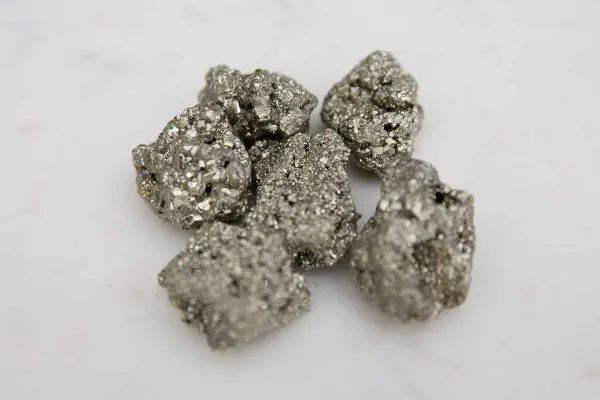There has always been plenty of great interest in the metaphysical and healing properties of different precious and semiprecious stones. Did you also know that there are instances when crystals pose a health risk to people?
There are three main occasions when a gemstone may pose a toxic risk to people: during normal handling, during the cutting process and when you swallow water where a crystal has been submerged (also known as the crystal elixir or crystal water bottle).
While crystals are an essential part of the New Age or mystic lifestyle, it’s necessary to be very careful when handling certain gemstones.
Some of the associated risks with handling, inhaling, and ingesting liquids that have been contaminated with certain gemstones include exposure to dangerous heavy metals, radioactivity, and silicosis.
Like other natural products, some rare gemstones are deadly even when just handled because of their natural radioactivity. While we are all exposed to some amount of radioactivity throughout the year, it’s different when you are exposed to a purely radioactive stone. The risk of cancer and radioactivity sickness increases.
Extra care must always be taken when you aren’t sure if your find is radioactive or not. There are also instances when it’s not safe to inhale the fine particles produced when a gemstone is cut. Silica and asbestos are both harmful to the lungs.
Finally, we have potential toxicity that results from drinking water containing chemicals leached from toxic gemstones. The general rule is never to submerge the actual crystal in the water because it is often risky to do so. You will understand once you read our curated list of deadly crystals below.
Table of Contents
Toxic Crystal List
1.Actinolite
Actinolite is known for sometimes containing asbestos. Not something that you would like to put into any elixir. Asbestos is a known carcinogen, and people spend a lot of money to get asbestos boards out of their homes. Don’t use this for anything that goes into your body!
2.Cinnabar
Cinnabar contains a small amount of mercury. Wash your hands thoroughly after handling cinnabar. Never touch your hands to any part of your face after taking any cinnabar. Cinnabar must never be used for any elixir.
3.Chicken-Blood Stone
The chicken-blood stone is an exciting gemstone because of its fantastic color combination but is graded “display only,” which means you can’t wear it, and handling chicken-blood stone poses a risk to humans.
During the cutting process, the fine dust from this crystal must not be inhaled either because of the large amount of mercury naturally found in it. Once it has been sculpted and finished, however, as long as you don’t ingest any part of it, it should be safe to handle. For good measure, however, always wash your hands.
4.Cobaltite
Cobaltite naturally contains cobalt, which can have poisonous effects if ingested. Never add to crystal elixirs – do not attempt this even once.
Consumption of cobalt in lethal amounts can cause various health problems, ranging from abnormal thickening of the blood, thyroid issues, tinnitus, nervous issues, deafness, and even fatal cardiomyopathy. This being the case, cobaltite must never be added directly to any liquid that is meant to be ingested.
5.Crocidolite
Also known as the Tiger’s Eye, having the same composition, crocidolite is touted as a harmful stone that is very toxic. Experts say that it is likely irradiated and has a fibrous form suggesting that it may also have some asbestos content. While it does have some healing properties, this crystal is never safe for making any raw concoctions or elixirs. Care must be taken in handling it and processing it as well.
6.Galena
The galena crystals are naturally toxic and should never be ingested. This being the case, it has to be handled carefully, just like other poisonous crystals, as it has around 90% lead. The lead content of galena should be enough to drive away anyone as information is very toxic to the body and can easily damage the organs. Galena is also known for its sensitivity to water, so should you have galena at home, it should never be moistened.
7.Malachite

Some experts state that malachite can only be used safely in its final, polished form. Do not create elixirs off of this crystal using any traditional method, as its toxins can leach into the water and cause bodily harm. If you wish to make a crystal elixir, it should be via the indirect technique by placing the malachite in a separate glass container. The water and the malachite should never touch. Malachite is also sensitive to oils and salts as the gemstone readily reacts with these chemicals.
Read more: Is Malachite Toxic to Humans?
8.Pyrite

Fool’s gold or pyrite is very toxic and contains an amount of sulfur. While it does have some healing properties, any elixir preparation should be indirect. Never mix pyrite with the water, as this may poison you. The resulting concoction is inedible and utterly unsafe for human consumption.
9.Quartz
Quartz is mainly toxic when its fine particles are inhaled. The only time that these fine particles are liberated is when the quartz is being ground, cut, or polished. Quartz, however, is not poisonous in its final form, but you have to wash it repeatedly to ensure that there remains no quartz dust anywhere on the crystal.
10.Torbernite
Aptly called the gemstone from hell, it is a deadly and deceptive green crystal that forms naturally in granite-rich rocks. Despite its natural beauty, torbernite is radioactive and produces radon. The outgassing can be fatal to anyone. The radon can trigger cancer, so stay away from it. It cannot be worn in any fashion, and even displaying it in an enclosed space is questionable. If at all kept in any storage facility, the torbernite has to be well-ventilated, and people must not stay in the same room as the torbernite for extended periods.



